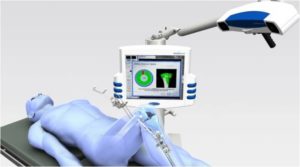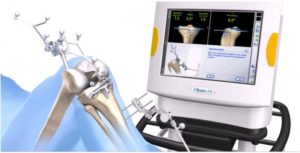
Computer Assisted Total Knee Surgery
The principle of the Computer Assisted total knee operation is simple:
The computer program produces a map of the patient’s knee. The map is reproduced on a large screen. The position of surgeon’s hands and instruments are incorporated in this map too.
The progress of the operation is monitored on the screen. The total knee surgery is turned into something akin to an instrumented landing of an aircraft.
This is theory. In practice, the computer systems used just now in total knee surgery are more simple.
The “image free” computer systems, manufactured for example by the implant manufacturers Aesculap, Smith&Nephew, Striker, and others, has a simple anatomical model of the limb embedded in the computer program. The surgeon upgrades this ideal map by the process of “registration”. This is done with the patient prepared for operation, lying on the operation table clad in sterile wraps.

Patient is wrapped in sterile wraps, lying on the operation table. The surgeon attaches beacons emitting infrared light on four points of the patient’s skeleton: pelvis, lower thigh bone (femur), upper shinbone (tibia), ankle. These beacons emit infrared light. The position of the beacons is registered by the infrared cameras placed above and besides the operated on leg. The information is stored in the computer program. The computer program uses the information to construct and display the axis of the patient’s skeleton.

The position of the beacons must be first “registered” by the cameras and the computer system.
The surgeon performs a predetermined sequence of movements with the patient’s leg, and these movements are registered by the infrared cameras. The computer software creates from these data a map of the patient’s leg, or rather of its axes, which are displayed on the screen. Note that the contours of the skeleton on the screen pictures do not depict the contours of the real patient’s skeleton. These contours represent a picture of an idealized skeleton embedded in the software program by the manufacturer. Only the axes are real. In this picture, the computer produced “loading line” = mechanical axis of the knee.
The surgeon also places similar beacons onto cutting instruments and uses special hand-held probes with mobile beacons to “register” the position of the knee joint surfaces and the planes of the cuts through the bone ends. The Stryker’s “computer navigation” system, for example, uses totally 14 beacons. It takes about five minutes to identify the beacons for the computer.
The computer then produces and displays a map to show the position of the joint surfaces (idealized), the planes of the cuts through the joint surfaces, the axes, the distance of cutting planes from the joint surfaces. In this picture the angle of the cut is 1 degree valgus and the cut is done 11 milimeters proximally (uppwards) from the joint surface of the femoral condyle.
After finishing the cut, the surgeon puts a plate with a beacon on the cut surface to assess the precision and the the computer displays the position of the plane. The surgeon has the option to make a new cut to change the plane of the cut surface.
The computer programs and hardware for computer assisted total knee surgery is under rapid development. The surgeons are testing the method in minimally invasive surgery. Unfortunately, many products are substandard, with low precision of the map created by the computer.
Note that the pictures on the screen lack anatomic details, they are idealized pictures of the skeleton, not corresponding to the individual patient’s real skeleton. This does not matter much when the patient’s skeleton is not deformed. But the method is not applicable in patients with more deformed knee skeletons; and precise in such patients the surgeon would have greatest advantage of computer assisted method of placing the cuts.
The precision of the method depends on the immovable placing of the beacons. This is also difficult to guarantee. The surgeon uses special screws screwed into the skeleton and on those screws he then places the light-emitting beacons. But this method cannot guarantee the immovability of the beacons during the forceful movements with the leg during the operation.
Cost of this method is significant. The computer-assisted total knee operation involves additional steps which take more time, and need special people attending to the computer system. Infrared beacons need to be anchored to bone and the scar after them produce inconvenience to the patient later and risk of infection.
The principal problem, however, is financial cost. The machines themselves are very expensive. The software price with each machine can be exorbitant. Moreover, the software is usually applicable to only one type of total knee prosthesis, and new software must be bought when the surgeon goes to another type of total knee prosthesis.